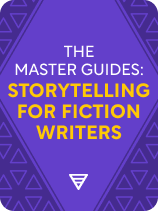

This article is an excerpt from the Shortform book guide to "The Master Guides: Storytelling for Fiction Writers" by Shortform. Shortform has the world's best summaries and analyses of books you should be reading.
Like this article? Sign up for a free trial here.
What do you want to be sure to include in every story you write? What are the essential ingredients that help make a story coherent and compelling?
According to storytelling experts, readers want two things: an emotional impact and a truth about life. If you want to satisfy these desires, the experts agree that your story needs three basic elements: a realistic and relatable protagonist, a goal that’s blocked by obstacles, and a big-picture theme.
Continue reading to find out what the experts have to say about each of these basic elements of a story.
Basic Story Element #1: A Realistic & Relatable Protagonist
The first basic element of a story is a protagonist who is realistic and relatable. This element is important not only for your readers but also for you as the writer. In Wired for Story, story coach Lisa Cron asserts that the protagonist helps you, as a writer, determine what information is important and what isn’t. The audience relates to the protagonist and understands the importance of the story’s events through the protagonist’s emotions. If the audience doesn’t understand how something makes your protagonist feel, the detail will seem unimportant.
In Story, Robert McKee explains that, when you show the audience that your protagonist has the same universal human desires as they do, they’ll empathize with that character. They’ll recognize themselves in your protagonist and feel emotionally invested in the character’s fate.
The more realistic your protagonist is, the more truth about life the audience will expect from them, making the character more compelling. As Thomas C. Foster explains in How to Read Literature Like a Professor, three-dimensional characters have backstories, strengths, weaknesses, likes, dislikes, and contradictions. Additionally, they grow and change throughout the story.
Stephen King notes in his book On Writing that adding dimension to your characters can make them more compelling. If you portray the motivations and complexities of otherwise wooden characters, the audience will find something to identify with.
Basic Story Element #2: A Goal That’s Blocked by Obstacles
Storytelling experts agree that your protagonist needs a goal to pursue throughout the story. This is the second basic element of a story. The protagonist’s goal is their overarching objective or aim. According to Lisa Cron, this is what drives the story internally. The emotional impact that something has on your protagonist—and your audience—is determined by how it impacts their ability to reach their goal.
The plot of a story is largely composed of obstacles that stand between your protagonist and their goal. Robert McKee elaborates that these obstacles need to be unexpected for both the protagonist and the audience. If events transpired exactly as the protagonist expected, they would simply achieve their goal, and you wouldn’t have a story. Therefore, the most basic unit of storytelling is: The protagonist takes a single action toward a goal and the world reacts in a way the protagonist doesn’t expect, creating an obstacle that complicates the protagonist’s plan to achieve their goal.
For example, here’s an unexpected obstacle from Finding Nemo: As Marlin watches his son Nemo swim out into dangerous open waters, he yells, “You’re going to get stuck out there!” in an attempt to scare Nemo back to safety (since Marlin’s goal is to keep his son safe). Nemo, angered by his father’s implication that he’s weak and determined to prove Marlin wrong, swims farther out into more dangerous waters. Marlin’s action provokes an unexpected reaction from Nemo, introducing new complications in Marlin’s path toward his goal.
Lisa Cron asserts that you shouldn’t coddle your protagonist by keeping them out of trouble or protecting them from obstacles. Instead, put them into situations that seem impossible to overcome—but aren’t—and show the audience the protagonist’s grueling, painful journey to achieving their goal. According to Cron, great stories are about how people change, and change is painful. This means your protagonist will suffer. Because we relate so closely to our characters, Cron says this is often a difficult thing for writers to do, but it’s also what makes a great story.
Basic Story Element #3: A Big-Picture Theme
Stephen King believes all good writing has a theme. Themes focus the story, making it feel more unified and coherent. Other experts agree that the theme is the third basic element of a story that you can’t do without. According to Rob Biesenbach, the author of Unleash the Power of Storytelling, the most effective themes involve values you share with your audience. King contends that the theme shouldn’t be premeditated. He recommends that you start with the story and discover the theme as you go along.
Some experts note that a story’s theme is often conveyed through internal change. Lisa Cron contends that any story is truly about how the protagonist changes as a result of the story’s events. She adds that the plot is the external events of the narrative, while the story is about the protagonist’s internal reactions.
Additionally, for a change in your protagonist’s life to be meaningful, Robert McKee argues that the change must occur because of your protagonist’s actions. A few random events that change your character’s life are fine to include in your story, but they don’t create meaning on their own. To communicate the kind of meaning that resonates with the audience on an intellectual and emotional level, show the cause and effect of your protagonist’s choices.

———End of Preview———
Like what you just read? Read the rest of the world's best book summary and analysis of Shortform's "The Master Guides: Storytelling for Fiction Writers" at Shortform.
Here's what you'll find in our full The Master Guides: Storytelling for Fiction Writers summary:
- How to capture and communicate emotional magic through fiction
- Advice from successful authors and storytelling experts
- The five steps of writing a story, from ideating to publishing






